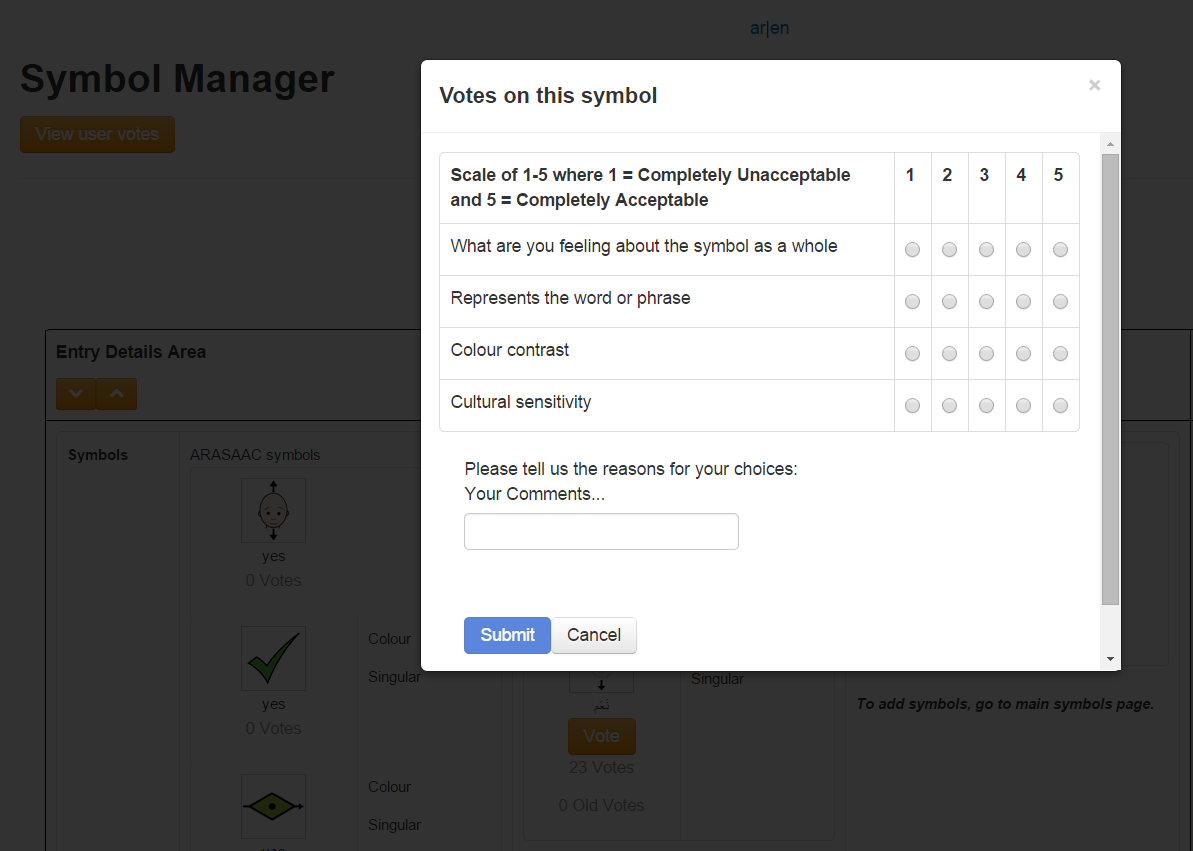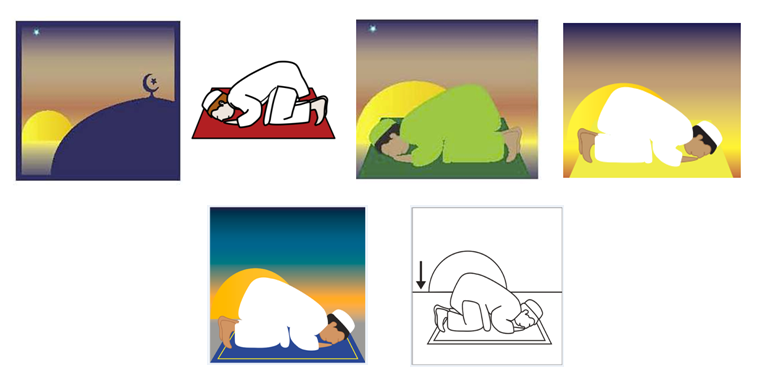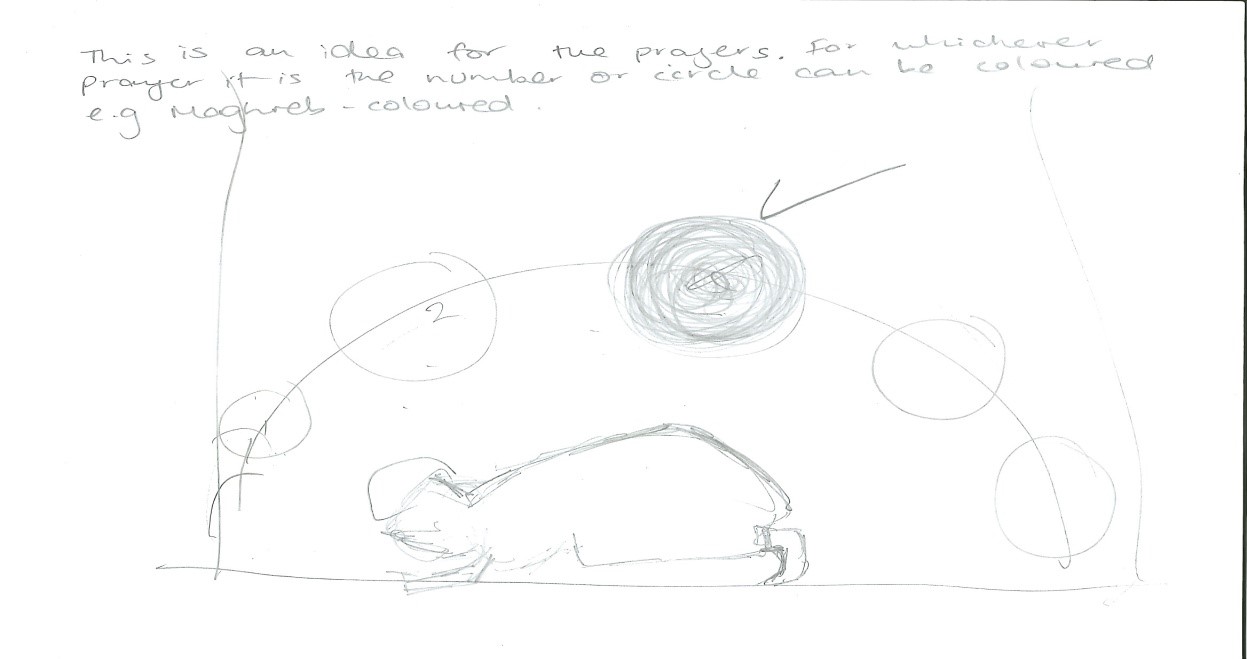Having finished the initial development of the new voting system it was time to trial it with the Mada team on 18th January. The view voters received looked similar to past views, but with only one set of symbols and a finally agreed version of the voting criteria, namely four choices on a scale of five in terms of acceptance plus a comments box.
The main comments from the voters regarding the system was that the images were not large enough, they wanted to have less clutter around the voting area and perhaps to be asked to guess the meaning of the symbol rather than to be given the text. The latter would mean there would need to be a two fold process where the participants first see the image without the word (Guessabilty – Cairney and Sless (1982), Hanson and Hartzema (1995), Yovetich and Young (1998) (Translucency – Haupt and Alant 2003, Evans et al 2006)) and then see the symbol with the word but help the graphic designer by saying where any issues lie with the imagery. This could take rather too long in the time available, but will need to be considered.
On Sunday 18th and Monday 19th January members of the Arabic Symbol Dictionary team in Doha held the second round of voting sessions at the Mada Assistive Technology Centre with members of the AAC Forum.
Tullah takes up the reporting…
“We were joined by 13 voters in session 1 and 7 voters in session 2. These therapists represented centres including Hamad Medical Corporation Special Needs Centre, Mada Assistive Technology Center, Qatar Academy – special needs section, researchers from Qatar University working in the field of special needs, Child Development Centre and Shafallah special needs school. We had a range of opinions from males and females, Qataris and non-Qataris, Arabic speakers and non-Arabic speakers. Despite the mirage of opinions and perspectives showcased throughout the sessions, there were some general opinions that came up again and again. It is these opinions of the majority that we will utilize to make the second round of adaptations to the symbols.
“The prayer symbols”
This series of symbols have definitely been the topic of much discussion in our team internally and also at the voting sessions. The image below depicts the transitions the symbol for “Maghrib prayer” or “evening prayer” (just after sunset), has taken (and will continue to take) in order to produce a symbol which the majority of people will be happy to use. The position of the sun, the colour and contrast of the sky and mat, the body structure and depiction, the clothing and religious sensitivities have made this symbol evolve into many different forms.
Here are some comments from our reviewers that helped us make the modifications…
“The symbol with the person praying is more representative of prayers. Mosque symbol seems more generalized, representing faith, Islam”
“Change the color of the sun in the sunset picture to reflect the sunset”
“Increase the color contrast and the background color”
Here is one suggestion from our forum members of how to depict all the 5 prayers at different times of the day.
“To stick figure or not to stick figure”
Other discussions were surrounding the team’s choice to use only stick figures for verbs and adjectives. This would solve complexities within the Arabic language of having to draw many versions of the symbol to fulfill the requirements of the Arabic language i.e having female and male versions for single, dual, plural, past and present tense forms. The general consensus amongst voters was that some symbol users will prefer stick figures and some full prefer the coloured/more detailed version. In any case, users of the Arabic symbol dictionary will have access to all ARASAAC symbols which have stick and coloured symbols for all words and can simply make adjustments to the symbol based on their preferences.
“The significance of colour choice”
Other voters believed that the colour scheme of the clothing used in our new symbols needed to be more consistent. Culturally, most Qatari women wear a black Abaya (dress) and shayla/hijab (head cover) and men wear the thawb (white dress) with a Ghutra (white head piece) on their head and Iqal to keep it in place.
In many of our symbols this has been depicted as seen in the symbol below.
However, in some symbols coloured clothing was used for several reasons;
- Younger symbol users are generally attracted to colours and have a tendency to want to use them more , this may also apply to those who have cognitive impairments (Stephenson, 2007)
- Children in Qatar wear Western looking coloured clothing and coloured uniforms to school
- It allows for more detail to be seen
- Arabic speaking countries aside from the gulf (which represent the vast majority of Arabs e.g Egypt, Syria, Iraq etc) wear coloured clothing and wearing all black is seen as depressing and for older women.
Our voters suggested that if we would like to make the symbols coloured then the symbols should reflect symbols of children with and without the shayla because children do not wear the shayla. However, if the symbol system is to be based on adults then the thawb + ghutra in white for male and abaya + shayla in black for female are necessary.
“Gestures- comprehendo or no comprehendo?”
Different gestures used to depict a concept was also a topic which facilitated a lot of discussion. The “yes” and “no” gestures were agreed not to have a universal indicator to depict these concepts. While an Arab may indicate a headshake as “no”, and an Indian might interpret this as “yes”. What ARASAAC indicates as “thank you” (hand over chest) was said by our voters to have many different meanings in the Arab culture but did not in any case mean thank you. The ARASAAC ‘thank you’ symbol (hand over chest) to them meant “count on me”/I’ll take care of it or “sorry” or “a woman’s gesture when she does not wish to shake hands with a male”.
“…and that’s a wrap”
Many of these very intriguing discussions took place and gave the Arabic Symbol Dictionary team lots to think about and our graphic designer, Dana a lot of work to do. It is amazing to see how one symbol can mean so many different things to so many people and such small details can be offensive to one ethnicity and small changes can be made to please another.
I am glad that our team has chosen a participatory approach as without our voters’ feedback this symbol dictionary would not fulfill their needs or the needs of symbol users in Qatar and the wider Arab world. It was reiterated time and time again by voters how much this symbol dictionary really is needed and how keen therapists are to get their hands on the final product.” Amatullah Kadous
References
Cairney, S., Sless, D.: Communication effectiveness of symbolic safety signs with different user groups. Applied Ergonomics, Vol. 13 (1982), 91-97
Evans D, Bowick L, Johnson M, Blenkhorn P (2006) Using iconicity to evaluate symbol use. In: Proceedings of the 10th international conference on computers helping people. Linz, Austria, pp 874–881
Hanson, E. C., Hartzema, A.: Evaluating pictograms as an aid for counselling elderly and low-literate patients. Journal of Pharmaceutical Marketing and Management, Vol. 9, No. 3 (1995), 51-55
Haupt, L., Alant, E.: The iconicity of picture communication symbols for rural Zulu children. South African Journal of Communication Disorders, Vol. 49 (2003), 40-49
Stephenson, J. (2007). The effect of color on the recognition and use of line drawings by children with severe intellectual disabilities. Augmentative and Alternative Communication, 23(1), 44–55. doi:10.1080/07434610600924457
Yovetich, W. S., Young, T. A: The Effects of Representativeness and Concreteness on the “Guessability” of Blissymbols. Augmentative and Alternative Communication, Vol. 4, (1988) 35-39.






